Natural Hazards - Earthquakes and Volcanoes
1/72
There's no tags or description
Looks like no tags are added yet.
Name | Mastery | Learn | Test | Matching | Spaced |
|---|
No study sessions yet.
73 Terms
Define an Earthquake?
A sudden release of stored energy (stress) caused by movement along a fault
Can be caused by volcanic activity, meteorites, and manmade explosion for nuclear bombs
Most common - along faults
Define a Fault?
A fracture in the Earth across which the two sides more relative to each other
What builds up enough to cause rocks to fracture and/or shift, sending off waves of seismic energy felt as earthquakes?
Stresses
We recognize faults beginning with rock relationship, formalized by what process
Steno’s Law Of Rock Relationship
Steno’s Law Of Rock Relationship is split into three sections. What are they? What do they state?
1) Law of original horizontality - Sedimentary rocks are in layers, layers were original horizontal. If we see rocks not horizontal, faulting is taking place
2) Law of superposition - In sedimentary rocks, each rock layer is younger than the layer beneath it and older than the layer above it
3) Law of original continuity - Sediment layers are continuous, ending only against a topographic high, by pinching out from lack of sediment, or by gradational change from one sediment to another
Faults are also known as what
Joints; which are fractures and cracks in brittle lithosphere rocks. However, if joints move due to large stress differential on either side of a fracture, they become faults
Movement ranges from mm to hundreds of km, resulting in tilting/folding of layers
What two terms are used to describe location in 3D space of deformed rock layers/describing faults
Dip & Strike
What does “Dip” mean when talking about the location in 3D space of deformed rock layers/describing faults
The angle of inclination from horizontal of titles layer
What does “Strike” mean when talking about the location in 3D space of deformed rock layers/describing faults
Compass bearing of horizontal line in titled layer
What are the two parts of a fault; describe each
Footwall - the rock beneath the fault
Hanging wall - rock above the fault
List and describe all types of faults
1) Dip-slip faults - dominated by vertical movement
Normal faults: hanging wall moves down due to extensional forces (pull apart); found in locations of seafloor spreading and where continents are pulling apart; results in zone of omission (layers are missing)
Reverse fault: hanging wall moves up due to compression stress (pushing); found where plates converge in continental collision or subduction; results in zone of repetition (layers are repeated vertically) CREATE THE LARGEST EARTHQUAKES
2) Strike-slip faults - moves side by side; convention works in either direction
Left Lateral: moves to the right toward you when you look from the side of the fault
Right Lateral: moves to the left toward you when you look from the side of the fault
Faults are complex zones of breakage with what surfaces
Irregular
Stress builds up in along faults over years until what occurs at weak points and propagates along fault surface
Ruptures
The point where ruptures first occur is called what
Hypocenter/focus
The point directly above the hypocenter/focus on the earth’s surface is called what
Epicenter
Energy during an fault rupture or earthquake is released as what
Seismic waves
A left step in right-lateral fault or a right step in a left-lateral fault both results in what
Compression, uplifts, creates hills and mountains
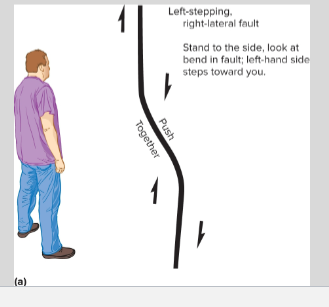
A right step in right-lateral fault or a left step in a left-lateral fault both results in what
Extension, down-dropping, basins and valleys
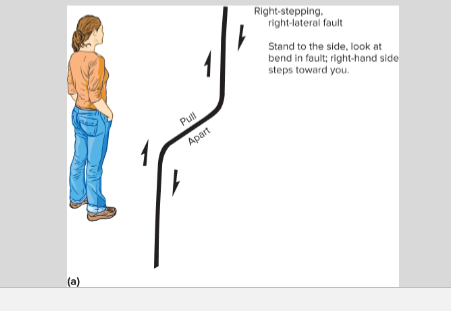
What is a Seismograph
The instrument that records the passing energy waves, aka seismic waves
What is a Seismogram
The actual recording of the passing waves
We use what four terms to describe seismic waves; describe them
Wavelength - distance between successive waves
Amplitude - Displacement between highest recorded point and level
Period - Time between waves (=1/frequency)
Frequency - Number of waves in one second

What are the two categories from seismic waves
Body waves: those that can pass through entire earth
Surface waves; those that move near surface only
Describe more on Body waves, as well as list the two types and their attributes
Faster than surface waves, have short periods, most energetic near earthquake hypocenter
P (Primary) waves
Fastest of all waves; always first to reach a recording station
Move as a push pull - pulses of compression then extension (like the wave through a Slinky toy)
Travel through solid, liquid or gas
Velocity dependent on density and compressibility of substance they are traveling through
S (Secondary) waves
Reach the station second after primary
Exhibit transverse motion - shearing or shaking particles at right angles to the wave’s path (like shaking one end of a rope)
Travel only through solids
Velocity depends on density and resistance to shearing of substances
Up/Down and side/side motion causes severe damage to buildings
What is the Lag Time
The time difference between the arrival of the P waves and the arrival of S waves
Describe more on Surface waves, as well as list the two types and their attributes
Travel near the Earth’s surface, created by body waves disturbing the surface; longer period than body waves and travel more slowly; carry significant energy great
Love waves
similar to S waves, except side to side in horizontal plane
Travel faster than Rayleigh waves
Do not move through air or water
Rayleigh waves
Similar to ocean waves; backward-rotating, elliptical motion producing horizontal and vertical shaking; feels like rocking a boat at sea
More energy is released as Rayleigh waves when earthquake hypocenter is close to the surface
In order to find the location of an earthquake, you need what
The distance of earthquake from three stations; find the Lag time, intersecting at 1 point all three circles
What is the magnitude of an earthquake
The measurement of strength of an earthquake; based on the largest amplitude and distance from epicenter
What is the Richter scale
A way to measure energy released in an earthquake; a log scale
Richter magnitude increases of one number the amount of energy increased by what and amplitude of what
32 times; 10
Large earthquakes are not just single event, but apart of what
A series of earthquakes over a number of years
In an earthquake series, the largest event in the series is known as
Mainshock
In an earthquake series, the smaller events preceding mainshocks in the series are known as
Foreshocks
In an earthquake series, the smaller events following mainshocks in the series are known as
Aftershocks
The velocity of seismic waves depend on what; and what happens in hard rocks/soft rocker
The material through which it is moving
Hard rocks - high velocity; lower amplitude
Soft rocks - lower velocity; high amplitude
Shaking is amplified when what happens
Tall buildings shake at the same period as the seismic waves
What is the Mercalli Intensity Scale
A system used to quantify what people feel during an earthquake and amount of damage; a scale from I to XII
P waves travel how much faster than S waves
1.7 times
The Mercalli intensity scale’s scaled amount of damage depends on what
1) Earthquake magnitude - Bigger earthquake, more likely death and damage
2) Distance from hypocenter - Usually (but not always), closer earthquakes —→ more damage
3) Type of rock or sediment - soft sediments amplified
4) Building style - amplified by ridged short buildings
5) Duration of shaking - longer shaking lasts, more buildings can be damaged; larger earthquakes longer duration
Most earthquakes can be explained by what theory
Theory of Plate tectonics
What are the three types of plate boundaries in relation to earhtquakes
Divergent plate boundaries - Small earthquakes and generally non-threatening
Transform plate boundaries - Generating large earthquakes
Convergent plate boundaries - Generating enormous (largest) earthquakes
At convergent boundaries, what method is used to help sceintistics predict future earthquake locations
Seismic Gap Method, which states if some segments of a fault have moved recently, it is reasonable to expect that unmoved portions will move next, to fill the gaps
Recount the Mexico City Earthquake and its significance
1985; created long distance destruction
350 km from Mexico City, but caused intense damage
Earthquake was expected due to the Michoacán seismic gap
9000+ people were killed by building collapses
Resonance between seismic waves, soft lake sediment foundations and improperly designed buildings
The western portion of the US has earthquakes due to what
Plate interactions (between the North American and Juan De Fuca Plate - Pacific Plate)
The San Andreas fault is what kind of plate boundary
Transform boundary (slide by to produce earthquakes); however its not a straight line so can get compressional stress and thrust faults
i.e Big Bend near Los Angles
Damaging earthquakes can result from what type of faulting
normal faulting (tensional stress)
How are earthquake probabilities when looking at long term predictions and short term predictions
Long term - fairly good based on paleoseismology (looking at pasts events in the region)
Short term - no. detailed behavior of faults may too unpredictable to ever allow short term predictions of earthquakes
Human triggered earthquakes are happened from what
Pumping fluid underground & disposal wells of drilling can lead to small earthquakes
Describe the Western North America and its relation to earthquakes
Has plate boundary zone earthquakes
Largely due to subduction of small plates and continued effects of the over Farallon plate which includes California into Utah, the eastern edge around Salt Lake City, and the Rio Grande Rift
Describe the “Stable” Central United States and its relation to earthquakes
Intraplate earthquakes
Clusters of earthquakes at few locations in Central U.S
Away from active plate edges; represents ancient rifts similar to Rio Grande Rift
Fewer earthquakes, but can be large
Future earthquakes will affect St. Louis, Memphis and Nashville, as those building are not designed for earthquake shaking, have soft sediments, and are of a large area/population
Most volcanoes are associated with what
Plate tectonics/plate boundaries; 73% at spreading centers, 15% at subduction zones, and the remaining 12% of volcanism occurs above hot spots
List how volcanoes interact with each plate interaction;
Spreading Center (divergent): hot, ductile mantle rock rises upward at ocean spreading centers where the lower pressure causes melting. When the magma erupts, it forms new oceanic crust in the form of shield volcanoes or underwater lava flows, contributing to ridge formation like the Mid-Atlantic Ridge. These have nonexplosive eruptions.
Subduction: carries oceanic plate (with water rich sediments) into hot mantle, where water lowers melting temp of rock. This process generates magma that is typically andesitic to rhyolitic in composition, and very explosive
Transform faults/continent-continent collisions: No volcanism
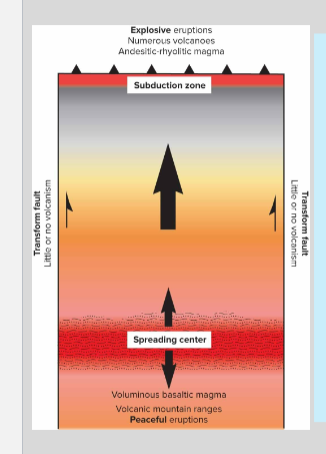
Variations of what things help determine whether eruptions are peaceful or explosive
Magma’s chemical compostion, ability to flow, gas content, and volume
What are the three V’s in discussing volcanoes
Viscosity - resistance to flow, high silica content magma high viscosity
Lower viscosity —→ more fluid behavior
Higher viscosity —→ thicker
Volatiles - more dissolve gases more explosive, as pressure decreased gases become bubble which expand rapidly leading to violent eruptions
Volume - large volumes more hazard, spreading center volcanoes have relatively peaceful eruptions but subduction zone volcanoes explore violently
Describe how Basaltic and Rhyolitic magma are with viscosity and volatiles
Basaltic magma - lowest viscosity
Rhyolitic magma - highest viscosity
Basaltic magma - low dissolve gases = peaceful eruptions
Rhyolitic magma - highest dissolve gases = violent
Try and chart comparison of three types of magma
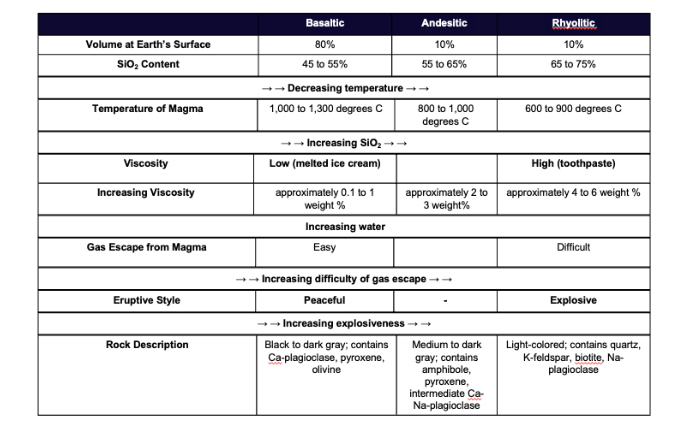
What are the three styles of volcanic eruptions and the name of the volcanoes
1) Nonexplosive - icelandic and Hawaiian
2) Somewhat explosive - Strombolian
3) Explosive - vulcanian and Plinian
Summarize how water and viscosity interact with the level of explosiveness
Low-water content, low-viscosity = nonexplosive eruptions
High-water content, high viscosity magma = explosive eruptions
List the 5 types of volcanic landforms and their explosiveness
1) Shield - low viscosity, low volatiles, large = peaceful
2) Flood basalts - low viscosity, low volatiles, verge large volume = connected to mass extinctions
3) Scoria (Cinder) Cone - medium viscosity, medium volatiles, small volume - explosive
4) Stratovolcano - high viscosity , high volatiles, very large volumes = explosive
5) Caldera - high viscosity, high volatiles, large large volume = explosive
Describe information on the volcanism at subduction zones
Most of the world’s famous volcanoes are subduction zone volcanoes
Many regions around subduction zones volcanoes are heavily populated
Erupt directly into atmosphere (not underwater) so have direct on worldwide climate
Ex. Cascade range, pacific coast US and Canada
Why do spreading centers have peaceful explosives, but subduction zones explode violently
Chemical Composition of the enviroment: Magma at subduction zones typically has a higher silica (SiO₂) content, which makes it more viscous compared to the basaltic magma found at spreading centers
Aluminum
Iron
Calcium
Sodium
Potassium
Silicon
Oxygen
Magnesium
other
List the top volcanic process and killer events when eruptions happen
Pyroclastic flows - 29%, the superhot, high speed turbulent cloud of ash, gas, and air is deadly
Tsunami - 21%
Lahar - 15%, volcanic mudflows, Mount Rainier on alert
Indirect (famine) - 23%
What is the Volcanic Explosivity Index
A semi-quantitative estimate of magnitude of volcanic eruptions, 0-8 more explosive, using volumes erupted and eruption-column height
The frequency of different VEI magnitudes is of what
An Inverse correlation
Bigger eruption, less frequent occurrences
Smaller eruptions, more frequent occurrences
How effective is volcanic monitering and warning systems
Efforts met with both failures and success
List the three signs of impending eruptions of volcanoes
1) Seismic waves, small earthquakes
2) Ground deformation; surface rises and falls in response to magma movement
3) Gas measurements
Chart the comparison of three types of magma
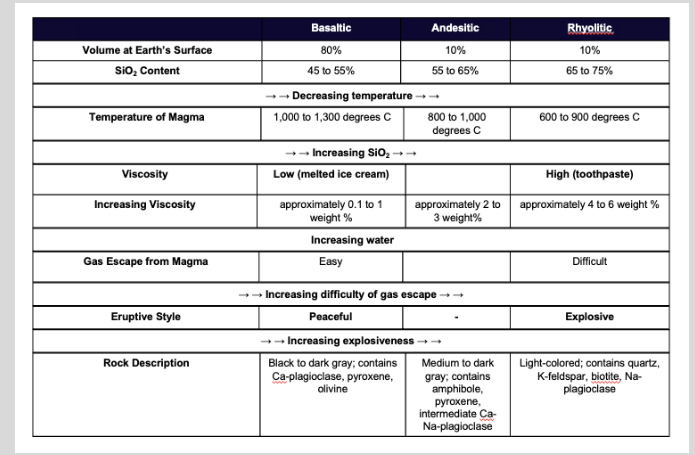
Describe the origin of cascade mountains
Subduction
Describe the 1980 mount st Helen eruption
high visocity got trapped, produced bulge small earthquakes occurred and allowed gas to expand and to to blast outwards, first blast lateral horizontal, which lead to vertical blast
Describe Supervolcanoes
A volcanic center that has had an eruption of magnitude 8 on the Volcano Explosivity Index (VEI)
What is the difference between pyroclastic flows vs surges
Pyroclastic flows, the superhot, high speed turbulent cloud of ash, gas and air is deadly – they result in about 29% of volcanic deaths
Pyroclastic surges, more steam and less pyroclastic material; no controlled by topography
What are lahars
Mixtures of water, volcanic ash, tephra, rock fragments, and chunks of ice that can flow like wet concrete
Why is Mt. Rainer considered to be so dangerous
Great height Extensive glacial cap Frequent earthquakes Active hot-water spring systems
What are vogs
A mixture that includes gases but is predominately aerosols (tiny particles and droplets) formed when volcanic gas reacts with moisture